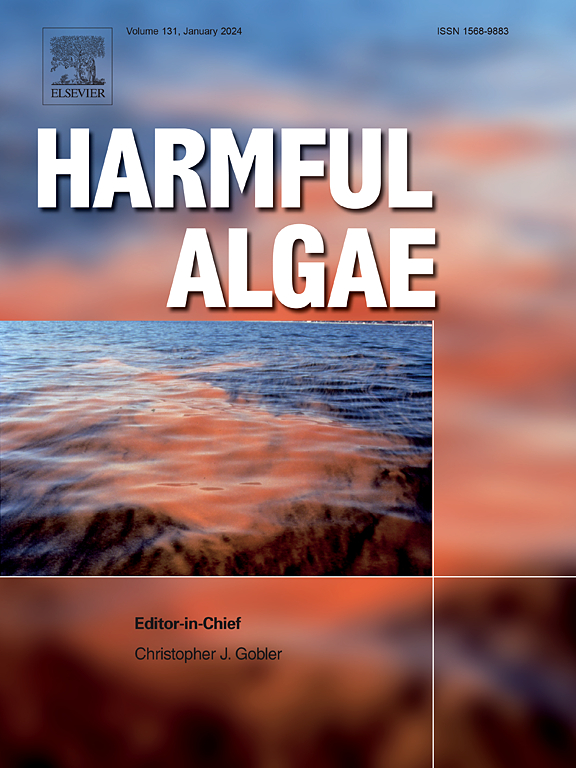从藻华到水龙头:将原水中的有害藻华指标与经过处理的饮用水中的蓝藻毒素联系起来
IF 4.5
1区 生物学
Q1 MARINE & FRESHWATER BIOLOGY
引用次数: 0
摘要
有害藻华(HABs)产生的蓝藻毒素可以通过摄入饮用水对人类健康产生负面影响。在大多数情况下,公共水系统(PWSs)已经证明,它们可以通过常规处理成功地去除低至中等水平的蓝藻毒素。强烈或频繁的水华使一些pss面临更高的治疗突破风险,这意味着蓝藻毒素可以通过饮用水处理过程,并且仍然有一些饮用水中蓝藻毒素水平的报道。本研究将根据第四项不受管制污染物监测规则(UCMR 4)采样的PWSs的蓝藻毒素饮用水发生率数据与定性的水源水HAB信息联系起来,了解水源水指标与饮用水发生率之间的关系。在监测期间(2018年至2020年),来自67个PWSs的约11万份蓝藻毒素分析结果中,有153份达到或高于最低报告水平(MRL),导致饮用水中出现率为0.14%。相关的定性数据表明,在饮用水中报告蓝藻毒素值≥MRL的系统中,23.9%也报告了有害藻华指标的存在,而在成品水中报告值≥MRL的系统中,1.7%没有报告任何有害藻华指标。比值比测试显示,如果观察到有害藻华指标,系统在饮用水中检测到蓝藻毒素的可能性会增加两倍以上。本研究证明了监测源水变化和观察到的处理变化对脆弱系统的重要性,因为这些可以促进及时调整处理并减轻成品水中蓝藻毒素突破的风险。本文章由计算机程序翻译,如有差异,请以英文原文为准。
From bloom to tap: Connecting harmful algal bloom indicators in source water to cyanotoxin presence in treated drinking water
Cyanotoxins produced by harmful algal blooms (HABs) can negatively impact human health through ingestion of drinking water. Under most circumstances, public water systems (PWSs) have demonstrated that they can successfully manage the removal of low-to-moderate levels of cyanotoxins with conventional treatment. Intense or frequent blooms put some PWSs at higher risk for treatment breakthrough, meaning cyanotoxins can pass through the drinking water treatment process, and there are still some instances of reported cyanotoxin levels in drinking water. This study links cyanotoxin drinking water occurrence data from PWSs sampled under the Fourth Unregulated Contaminant Monitoring Rule (UCMR 4) with qualitative source water HAB information to understand the relationship between source water indicators and drinking water occurrence. During the monitoring period (2018 to 2020), 153 of approximately 110,000 total cyanotoxin analytical results from 67 PWSs were observed at or above the minimum reporting level (MRL), resulting in a 0.14 percent rate of occurrence in drinking water. The associated qualitative data indicated that 23.9 percent of systems with a cyanotoxin reported value ≥ MRL in drinking water also reported the presence of a HAB indicator while 1.7 percent of systems with a reported value ≥ MRL in finished water did not report any HAB indicators. Odds ratio testing revealed that a system is more than twice as likely to have a cyanotoxin detection in drinking water if a HAB indicator is observed. This study demonstrates the importance of monitoring source water changes and observed treatment changes for vulnerable systems, as these can facilitate timely adjustments to treatment and mitigate the risks of cyanotoxin breakthrough in finished water.
求助全文
通过发布文献求助,成功后即可免费获取论文全文。
去求助
来源期刊

Harmful Algae
生物-海洋与淡水生物学
CiteScore
12.50
自引率
15.20%
发文量
122
审稿时长
7.5 months
期刊介绍:
This journal provides a forum to promote knowledge of harmful microalgae and macroalgae, including cyanobacteria, as well as monitoring, management and control of these organisms.
 求助内容:
求助内容: 应助结果提醒方式:
应助结果提醒方式:


